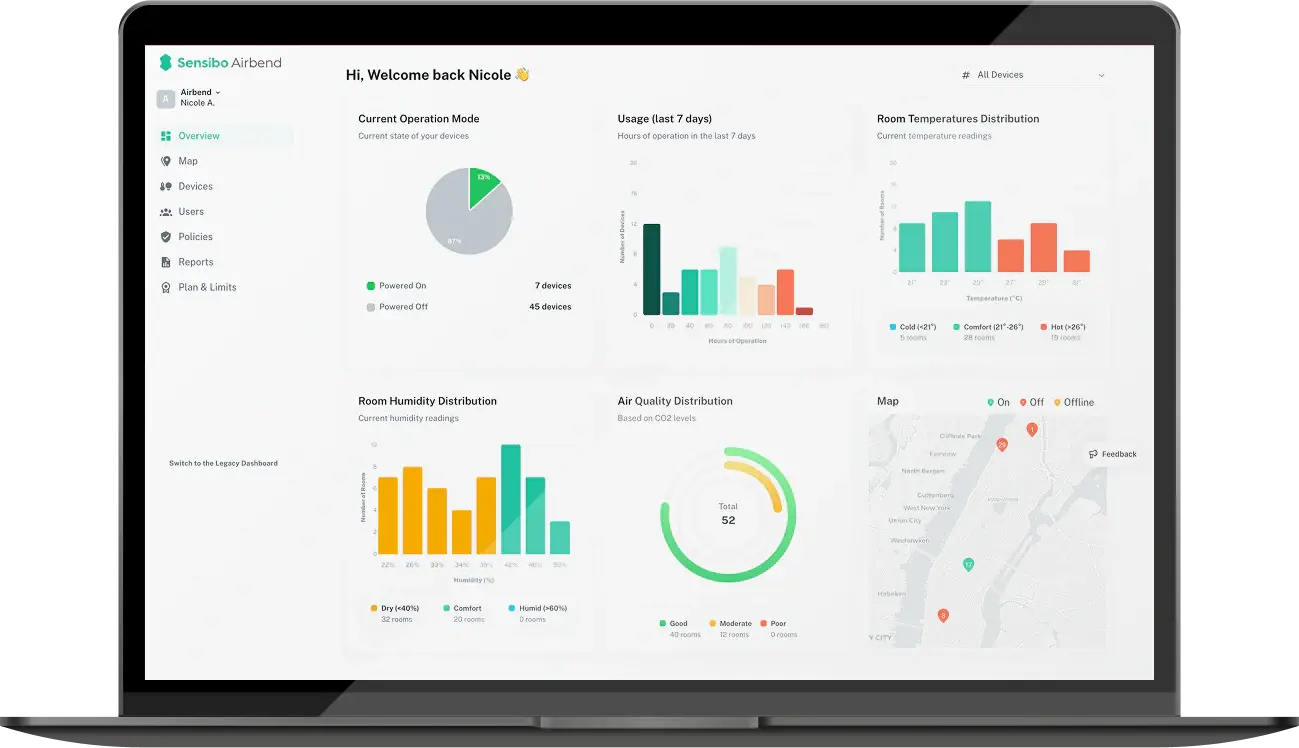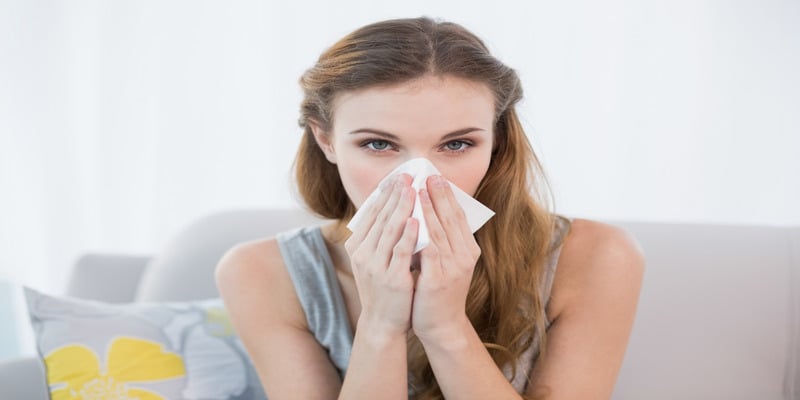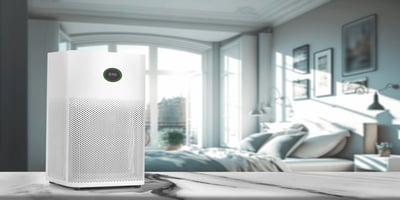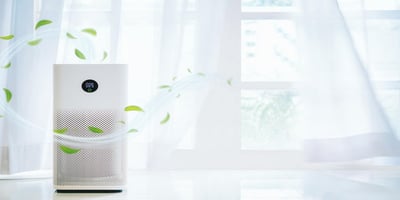Do Air Purifiers Help with Allergies? Understanding Their Role in Your Health
Key Takeaways
- Mixed Results Are Normal: Clinical studies show air purifiers work well for some people and allergen types (especially dust mites) but provide minimal benefit for others (particularly pet allergies). Your individual sensitivity, specific triggers, and allergen behavior determine whether you'll see real improvement.
- Airborne vs. Surface Allergens: Air purifiers only capture particles floating in the air, but most allergens spend more time settled on surfaces like furniture, bedding, and carpets. They're most helpful for people whose symptoms worsen when dust gets stirred up, not those reacting to surface contact.
- HEPA Filtration Is Non-Negotiable: True HEPA filters removing 99.97% of 0.3-micron particles are essential - avoid "HEPA-like" marketing terms. Smart sensors that automatically adjust to actual air quality changes outperform fixed-speed units by responding immediately when allergen levels spike.
- Size and Placement Matter More Than Price: Room size matching and central positioning away from walls determine effectiveness more than expensive features. Calculate your room volume and choose units with appropriate CADR ratings rather than focusing on premium pricing or fancy add-ons.
- Supplement, Don't Replace Other Strategies: Air purifiers work best alongside allergen source control (HEPA bedding covers, humidity management, regular cleaning) and medical treatment. They're valuable tools in comprehensive allergy management but can't solve allergen problems by themselves.
Your nose starts running the moment you walk into certain rooms. Your eyes water when you visit friends with cats. Spring arrives, and suddenly you're sneezing every morning. Sound familiar? You're not alone - allergic reactions affect over 50 million Americans each year, making allergies one of the most common chronic conditions in the country.
The question many allergy sufferers ask: Can an air purifier actually help? The answer isn't as straightforward as you might hope. Air purifiers for allergies can make a real difference for some people, while others see cleaner air readings but still struggle with the same symptoms. Success depends on what triggers your allergies, how severe your reactions are, and how you use air purification alongside other management strategies.
Your Immune System's Case of Mistaken Identity
Allergies happen when your immune system gets confused about what's dangerous. Normally, your body produces antibodies to fight off genuine threats like bacteria and viruses. But during an allergic reaction, these same protective mechanisms kick into overdrive against harmless substances like tree pollen or cat hair.
This confusion starts during your first exposure to an allergen. Your immune system "remembers" the substance and prepares for future encounters. When you meet that allergen again, your body launches an inflammatory response - releasing histamine and other chemicals that cause the familiar parade of symptoms: sneezing, runny nose, itchy eyes, congestion, and sometimes breathing difficulties.
Research shows that eight out of ten Americans encounter dust mites regularly, while six out of ten deal with cat or dog dander in their daily environments. Your reaction intensity depends on your genetic makeup, how much exposure you get, and your individual sensitivity threshold.
The Allergy Calendar: When and Where Symptoms Strike
Outdoor Allergies Follow Nature's Schedule
Spring allergies start with tree pollen, typically hitting hardest from March through May. Oak, maple, birch, and cedar trees release massive amounts of pollen during their blooming periods. Summer brings grass pollen - those perfectly manicured suburban lawns become sneeze-inducing nightmare zones for sensitive people.
Fall ushers in ragweed season, the notorious troublemaker that can travel hundreds of miles on wind currents. A single ragweed plant produces up to a billion pollen grains per season, explaining why autumn allergies can feel so overwhelming.
Pollen levels peak during morning hours and early afternoon, making these the worst times for outdoor activities. Windy, warm days scatter more pollen, while rain provides temporary relief by washing particles from the air.
Indoor Allergens Never Take a Break
 Dust mites cause year-round misery for millions of people. These microscopic creatures thrive in warm, humid environments - exactly the conditions found in most homes. They feast on dead skin cells and produce waste particles that become airborne whenever you disturb bedding, upholstered furniture, or carpeting.
Dust mites cause year-round misery for millions of people. These microscopic creatures thrive in warm, humid environments - exactly the conditions found in most homes. They feast on dead skin cells and produce waste particles that become airborne whenever you disturb bedding, upholstered furniture, or carpeting.
Pet allergens stick around long after animals leave rooms. Cat allergens are particularly persistent because they're small, lightweight, and clingy. Dog allergens tend to be larger and settle more quickly, but they still accumulate on surfaces throughout homes where pets live.
Mold grows wherever moisture accumulates - bathrooms, basements, kitchens, and anywhere water damage has occurred. Mold spores become airborne when disturbed and can trigger reactions in sensitive individuals throughout the year.
What to Do When Allergies Attack
Quick Response Tactics
When symptoms flare up, your first move should reduce continued exposure. For pollen reactions, get indoors and stay there during peak hours. Shower immediately after being outside to remove pollen from your hair and skin. Change clothes and wash them separately from other laundry.
For indoor allergen reactions, identify and address the immediate trigger. If pet dander seems responsible, increase distance from animals and improve air circulation. For dust mite reactions, consider what activity stirred up allergens - making beds, vacuuming, or moving stored items often trigger symptoms.
Medication Management
Antihistamines block your body's histamine production, reducing the inflammatory cascade that causes most allergy symptoms. They work best when taken before exposure rather than after symptoms begin.
Nasal corticosteroid sprays provide more comprehensive relief by directly reducing inflammation in nasal passages. These medications take several days to reach full effectiveness, so consistency matters more than timing.
For persistent or severe symptoms, professional allergy testing can identify specific triggers. Skin prick tests and blood work reveal which substances cause reactions, enabling targeted avoidance and treatment strategies.
Air Purifiers: The Evidence on Allergy Relief
 What Research Actually Shows
What Research Actually Shows
Clinical studies reveal a mixed picture of air purifier effectiveness for allergies. A major 2020 study found that HEPA air purifiers significantly reduced medication needs for people with dust mite allergies, showing measurable improvements in both air quality and symptom management.
However, other research tells a different story. A well-designed study of cat-allergic patients found that while HEPA units successfully removed airborne cat allergens, participants didn't experience meaningful symptom relief. Air got cleaner, but people still felt just as miserable.
The difference often comes down to allergen behavior. Dust mite particles can stay airborne long enough for filtration systems to capture them. Cat and dog allergens, however, often ride on larger particles that settle quickly onto surfaces where air purifiers can't reach them.
Real-World Performance Varies
Air purifiers for allergies work best for people whose reactions come primarily from airborne particles rather than settled allergens. If your symptoms worsen when you disturb dust, vacuum carpets, or shake out bedding, an air purifier might provide noticeable relief.
People whose allergies stem mainly from surface contact - touching contaminated furniture, walking on allergen-loaded carpets, or sleeping on unwashed bedding - typically see less benefit from air purification alone.
The timing of air purifier operation also affects results. Running units continuously provides better allergen control than intermittent use, since allergens constantly enter homes and get redistributed by normal activities.
Choosing an Air Purifier That Actually Helps
HEPA Filtration: The Non-Negotiable Standard
True HEPA filters remove 99.97% of particles 0.3 microns and larger - a specification that targets the size range most difficult to capture. Smaller and larger particles get trapped even more efficiently, making HEPA filtration highly effective for common allergens.
Ignore marketing terms like "HEPA-style" or "HEPA-like" - these don't meet true HEPA standards and may provide significantly less allergen removal. Only buy units that specify "True HEPA" or provide documentation of 99.97% efficiency ratings.
Size Matching and Air Circulation
Room size determines air purifier effectiveness more than fancy features or high prices. Calculate your room's volume (length × width × height), then choose a unit rated for that space or larger.
Clean Air Delivery Rate (CADR) numbers indicate how much filtered air a unit produces per minute. Higher CADR ratings mean faster air cleaning, but they often come with increased noise levels.
Placement matters enormously. Central room positioning away from walls and furniture maximizes air circulation. Corner placement or positions behind furniture dramatically reduce effectiveness.
Smart Features That Make a Difference
Automatic air quality sensors that adjust fan speeds based on actual contamination levels provide more effective allergen control than fixed-speed operation. These systems respond immediately when activities like cooking, cleaning, or pet grooming increase airborne allergen levels.
Multiple filtration stages can enhance allergen removal. Pre-filters capture larger particles like pet hair and lint, extending HEPA filter life. Activated carbon filters address odors and chemical sensitivities that sometimes accompany allergic reactions.
Sensibo Pure: Intelligent Allergy Management

The Sensibo Pure combines multi-stage HEPA filtration with smart environmental monitoring designed specifically for allergy management. Built-in sensors detect allergen particles across different sizes, automatically adjusting operation based on real-time air quality changes.
The system includes smartphone app integration for monitoring air quality trends and receiving alerts when allergen levels spike. Voice control capabilities let you adjust settings without physical interaction during severe allergy episodes.
PureBoost technology sets this system apart by integrating with existing HVAC equipment. When sensors detect elevated allergen levels, the system can activate your air conditioning fan to increase whole-house circulation, maximizing allergen removal beyond single-room limitations.
Complete Allergy Management Beyond Air Purifiers
Address the Source First
Air purifiers handle airborne allergens, but most allergy-causing substances spend more time on surfaces than floating in air. Allergen-proof bedding covers, regular hot-water washing of linens, and humidity control below 50% target dust mites at their source.
Pet allergen management requires regular bathing and grooming, though allergic individuals should avoid doing this themselves. Creating pet-free zones, especially bedrooms, provides allergen-reduced spaces for recovery.
Surface cleaning with damp cloths traps allergens instead of redistributing them into air. Vacuum cleaners with HEPA filters prevent captured allergens from escaping back into rooms during cleaning.
Timing Your Defense Strategy
Understanding allergen patterns enables proactive management. Pollen allergies respond well to pre-seasonal medication starting, window closure during peak pollen times, and outdoor activity scheduling for late afternoon or evening hours when pollen counts typically drop.
Air purifiers for allergies work most effectively with continuous operation rather than turning them on only during symptomatic periods. Establishing clean baseline air quality before allergen seasons begin can reduce symptom severity when exposure levels increase.
Medical Integration
Air purification complements but cannot replace appropriate medical treatment. Allergists often recommend starting medications 2-3 weeks before expected seasonal symptoms, while maintaining year-round treatment for persistent indoor allergens.
Immunotherapy provides long-term benefits by gradually reducing sensitivity to specific allergens. This treatment requires years of consistent therapy but can deliver lasting relief that continues long after treatment completion.
FAQ
Do air purifiers actually help with allergies?
Air purifiers for allergies can provide meaningful relief for some people, particularly those sensitive to airborne particles like dust mites and certain pollens. Clinical studies show mixed results - some demonstrate clear symptom improvements while others show air quality improvements without corresponding health benefits. Success depends on your specific allergen triggers and sensitivity patterns.
What type of air purifier works best for allergies?
True HEPA air purifiers offer the most reliable allergen removal. Look for units that meet EPA standards of 99.97% particle removal at 0.3 microns, have appropriate room size ratings, and include automatic sensors that adjust operation based on actual air quality conditions.
How long before air purifiers help allergy symptoms?
Some people notice improvements within days of continuous operation, while others need weeks of consistent use. Timeline depends on initial allergen levels in your home, which specific allergens trigger your symptoms, and your individual sensitivity threshold.
Can air purifiers replace allergy medications?
Air purifiers for allergies should supplement, not replace, medical treatment. While they may reduce allergen exposure and potentially decrease medication needs, they cannot eliminate all allergen sources or address settled allergens on surfaces. Work with an allergist to integrate air purification into your overall management strategy.
Where should I put an air purifier for best allergy relief?
Place units in rooms where you spend the most time, especially bedrooms. Central positioning away from walls and furniture maximizes air circulation effectiveness. For comprehensive coverage, consider multiple units or HVAC integration through smart systems.
Do air purifiers help with pet allergies?
Results vary significantly for pet allergies. While air purifiers can remove some airborne pet allergens, much of the problem comes from settled dander on furniture, carpets, and clothing. Combine air purification with regular pet grooming, frequent surface cleaning, and pet-free zones for better results.
Are expensive air purifiers worth it for allergies?
Price doesn't guarantee allergy relief effectiveness. Focus on verified HEPA filtration, proper room size coverage, and smart operation features rather than premium pricing. Some moderately priced units with correct specifications outperform expensive models lacking proper filtration or adequate air circulation.



































.jpg?height=200&name=photo_2023-12-29_20-01-46%20(1).jpg)


